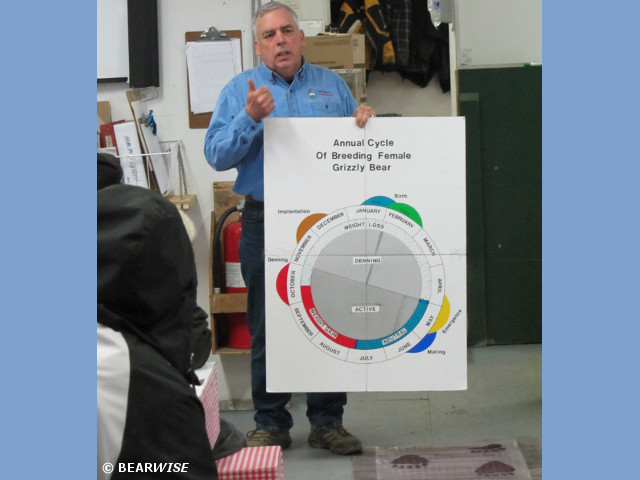Andy McMullen’s BEARWISE bear safety training courses build on consensus opinion of leading experts on living, working and traveling safely in bear country. Andy’s long history of working cooperatively with clients allows BEARWISE to custom design training to meet your specific needs. Andy uses lecture, innovative props and video clips to help participants understand four core programs:
- Staying Safe in Bear Country
- Polar Bears: A Guide to Safety
- Working in Bear Country
- Living in Bear Country
Staying Safe in Bear Country is an educational program for anyone who lives, travels, or works in Grizzly and Black bear country. Leading expertise on bear behaviour is used to promote human safety.
Topics covered:
- Grizzly and Black Bear Distribution
- Grizzly and Black Bear Identification
- Bear Ecology
- Grizzly and Black Bear Behaviour
- Types of Encounters and How to Respond
- Responding to Bear Approaches and Attacks
- Preventing Problems with Bears
- Bear Deterrents
Polar Bears: A Guide to Safety focuses on prevention of negative human encounters with polar bears. Inuit Qaujimajatuqangit (Traditional Knowledge) and scientific expertise informs material presented on polar bear behaviour and human safety around bears.
Target audiences include those who live, work and recreate in polar bear country, even those indigenous to the area.
Topics covered:
- Polar Bear Behaviour
- Seasonal Distribution
- Preventing Encounters
- Attractant Management
- Detection and Deterrents
- Polar Bear Encounters and How to Respond
- Polar Bear Approaches and Attacks
Working in Bear Country targets people who supervise field crews or manage field camps in bear country.
This bear/human safety program addresses:
- Field Safety, including: employee responsibilities, helicopter support
- Camp Safety, including: location & design,attractant management
- Detection systems
- Bear Deterrents
- Firearms
- Bear Response Planning
Living in Bear Country provides practical advice on how to minimize problems with bears near homes and cottages.
Communities or individuals can make simple adjustments to their daily routines that will reduce property damage and increase human safety.
Topics covered:
- Bear Biology and Ecology
- Individual Responsibility
- Attractant Management
- Reporting
- Community Responsibility
- Community Planning
- Education
- Attractant Management
- Monitoring Bear and Human Conflict
- Deterring, Moving, or Destroying Bears
Range Component: In addition to the four bear safety training programs, a range component can be added so that participants can practice using various commonly available deterrents and lethal rounds in a controlled environment. Range time is set according to number of participants and variety of deterrents being demonstrated.
Training Venue: Client arranged. Your operational base or field camps.
Time Required: Approximately two and half to three hours per training program.
Group Size: Limited by the training venue only.
Rate: BEARWISE uses a Per Diem rate, contact andy@bearwise.ca
NOTE: An instruction day may include multiple training sessions to maximize the number of people trained and in order to accommodate work schedules.

















